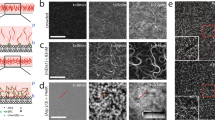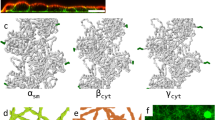Abstract
Contractile actomyosin network flows are crucial for many cellular processes including cell division and motility, morphogenesis and transport. How local remodelling of actin architecture tunes stress production and dissipation and regulates large-scale network flows remains poorly understood. Here, we generate contracting actomyosin networks with rapid turnover in vitro, by encapsulating cytoplasmic Xenopus egg extracts into cell-sized ‘water-in-oil’ droplets. Within minutes, the networks reach a dynamic steady-state with continuous inward flow. The networks exhibit homogeneous, density-independent contraction for a wide range of physiological conditions, implying that the myosin-generated stress driving contraction and the effective network viscosity have similar density dependence. We further find that the contraction rate is roughly proportional to the network turnover rate, but this relation breaks down in the presence of excessive crosslinking or branching. Our findings suggest that cells use diverse biochemical mechanisms to generate robust, yet tunable, actin flows by regulating two parameters: turnover rate and network geometry.
This is a preview of subscription content, access via your institution
Access options
Access Nature and 54 other Nature Portfolio journals
Get Nature+, our best-value online-access subscription
$29.99 / 30 days
cancel any time
Subscribe to this journal
Receive 12 print issues and online access
$209.00 per year
only $17.42 per issue
Buy this article
- Purchase on Springer Link
- Instant access to full article PDF
Prices may be subject to local taxes which are calculated during checkout




Similar content being viewed by others
Data availability
The data that support the plots within this paper and other findings of this study are available from the corresponding author upon request.
References
Blanchoin, L., Boujemaa-Paterski, R., Sykes, C. & Plastino, J. Actin dynamics, architecture, and mechanics in cell motility. Physiol. Rev. 94, 235–263 (2014).
Pollard, T. D. Actin and actin-binding proteins. Cold Spring Harb. Perspect. Biol. 8, a018226 (2016).
Brieher, W. Mechanisms of actin disassembly. Mol. Biol. Cell 24, 2299–2302 (2013).
Ono, S. The role of cyclase-associated protein in regulating actin filament dynamics- more than a monomer-sequestration factor. J. Cell Sci. 126, 3249–3258 (2013).
Ono, S. Functions of actin-interacting protein 1 (AIP1)/WD repeat protein 1 (WDR1) in actin filament dynamics and cytoskeletal regulation. Biochem. Biophys. Res. Commun. 506, 315–322 (2018).
Carvalho, A., Desai, A. & Oegema, K. Structural memory in the contractile ring makes the duration of cytokinesis independent of cell size. Cell 137, 926–937 (2009).
Mayer, M., Depken, M., Bois, J. S., Julicher, F. & Grill, S. W. Anisotropies in cortical tension reveal the physical basis of polarizing cortical flows. Nature 467, 617–621 (2010).
Yi, K. et al. Dynamic maintenance of asymmetric meiotic spindle position through Arp2/3-complex-driven cytoplasmic streaming in mouse oocytes. Nat. Cell Biol. 13, 1252–1258 (2011).
Hawkins, R. J. et al. Spontaneous contractility-mediated cortical flow generates cell migration in three-dimensional environments. Biophys. J. 101, 1041–1045 (2011).
Liu, Y.-J. et al. Confinement and low adhesion induce fast amoeboid migration of slow mesenchymal cells. Cell 160, 659–672 (2015).
Lenz, M., Thoresen, T., Gardel, M. L. & Dinner, A. R. Contractile units in disordered actomyosin bundles arise from F-actin buckling. Phys. Rev. Lett. 108, 238107 (2012).
Murrell, M. P. & Gardel, M. L. F-actin buckling coordinates contractility and severing in a biomimetic actomyosin cortex. Proc. Natl Acad. Sci. USA 109, 20820–20825 (2012).
Linsmeier, I. et al. Disordered actomyosin networks are sufficient to produce cooperative and telescopic contractility. Nat. Commun. 7, 12615 (2016).
Ennomani, H. et al. Architecture and connectivity govern actin network contractility. Curr. Biol. 26, 616–626 (2016).
McFadden, W. M., McCall, P. M., Gardel, M. L. & Munro, E. M. Filament turnover tunes both force generation and dissipation to control long-range flows in a model actomyosin cortex. PLoS Comput. Biol. 13, e1005811 (2017).
McCall, P. M., MacKintosh, F. C., Kovar, D. R. & Gardel, M. L. Cofilin drives rapid turnover and fluidization of entangled F-actin. Preprint at https://www.biorxiv.org/content/early/2017/06/26/156224 (2017).
Tan, T. H. et al. Self-organization of stress patterns drives state transitions in actin cortices. Sci. Adv. 4, eaar2847 (2018).
Bendix, P. M. et al. A quantitative analysis of contractility in active cytoskeletal protein networks. Biophys. J. 94, 3126–3136 (2008).
Hayakawa, K., Tatsumi, H. & Sokabe, M. Actin filaments function as a tension sensor by tension-dependent binding of cofilin to the filament. J. Cell Biol. 195, 721–727 (2011).
Galkin, V. E., Orlova, A. & Egelman, E. H. Actin filaments as tension sensors. Curr. Biol. 22, R96–R101 (2012).
Alvarado, J., Sheinman, M., Sharma, A., MacKintosh, F. C. & Koenderink, G. H. Force percolation of contractile active gels. Soft Matter 13, 5624–5644 (2017).
Merkle, D., Kahya, N. & Schwille, P. Reconstitution and anchoring of cytoskeleton inside giant unilamellar vesicles. ChemBioChem 9, 2673–2681 (2008).
Ideses, Y., Sonn-Segev, A., Roichman, Y. & Bernheim-Groswasser, A. Myosin II does it all: assembly, remodeling, and disassembly of actin networks are governed by myosin II activity. Soft Matter 9, 7127–7137 (2013).
Kohler, S., Schmoller, K. M., Crevenna, A. H. & Bausch, A. R. Regulating contractility of the actomyosin cytoskeleton by pH. Cell Rep. 2, 433–439 (2012).
Rivas, G., Vogel, S. K. & Schwille, P. Reconstitution of cytoskeletal protein assemblies for large-scale membrane transformation. Curr. Opin. Chem. Biol. 22, 18–26 (2014).
Carvalho, K. et al. Actin polymerization or myosin contraction: two ways to build up cortical tension for symmetry breaking. Phil. Trans. R. Soc. B 368, 20130005 (2013).
Mak, M., Zaman, M. H., Kamm, R. D. & Kim, T. Interplay of active processes modulates tension and drives phase transition in self-renewing, motor-driven cytoskeletal networks. Nat. Commun. 7, 10323 (2016).
Hiraiwa, T. & Salbreux, G. Role of turnover in active stress generation in a filament network. Phys. Rev. Lett. 116, 188101 (2016).
Banerjee, D. S., Munjal, A., Lecuit, T. & Rao, M. Actomyosin pulsation and flows in an active elastomer with turnover and network remodeling. Nat. Commun. 8, 1121 (2017).
Gardel, M. L. et al. Elastic behavior of cross-linked and bundled actin networks. Science 304, 1301–1305 (2004).
Lieleg, O., Schmoller, K. M., Claessens, M. M. A. E. & Bausch, A. R. Cytoskeletal polymer networks: viscoelastic properties are determined by the microscopic interaction potential of cross-links. Biophys. J. 96, 4725–4732 (2009).
Wuhr, M. et al. Deep proteomics of the Xenopus laevis egg using an mRNA-derived reference database. Curr. Biol. 24, 1467–1475 (2014).
Pinot, M. et al. Confinement induces actin flow in a meiotic cytoplasm. Proc. Natl Acad. Sci. USA 109, 11705–11710 (2012).
Abu-Shah, E. & Keren, K. Symmetry breaking in reconstituted actin cortices. eLife 3, e01433 (2014).
Abu-Shah, E., Malik-Garbi, M. & Keren, K. in Building a Cell from its Component Parts (eds Ross, J. & Marshall, W.) (Elsevier, Amsterdam, 2014).
Field, C. M., Nguyen, P. A., Ishihara, K., Groen, A. C. & Mitchison, T. J. in Methods in Enzymology: Reconstituting the Cytoskeleton (ed. Vale, R. D.) Vol. 540, 399–415 (Elsevier, Amsterdam, 2014).
Prost, J., Julicher, F. & Joanny, J. F. Active gel physics. Nat. Phys. 11, 111–117 (2015).
Lewis, O. L., Guy, R. D. & Allard, J. F. Actin–myosin spatial patterns from a simplified isotropic viscoelastic model. Biophys. J. 107, 863–870 (2014).
Landau, L. D. & Lifshitz, E. M. Theory of Elasticity Vol. 7 (Elsevier, New York, 1986).
Jansen, S. et al. Single-molecule imaging of a three-component ordered actin disassembly mechanism. Nat. Commun. 6, 7202 (2015).
Courson, D. S. & Rock, R. S. Actin crosslink assembly and disassembly mechanics for alpha-actinin and fascin. J. Biol. Chem. M110, 123117 (2010).
Raz-Ben Aroush, D. et al. Actin turnover in lamellipodial fragments. Curr. Biol. 27, 2963–2973.e14 (2017).
Kim, T., Gardel, M. L. & Munro, E. Determinants of fluidlike behavior and effective viscosity in cross-linked actin networks. Biophys. J. 106, 526–534 (2014).
Pinto, I. M., Rubinstein, B., Kucharavy, A., Unruh, J. R. & Li, R. Actin depolymerization drives actomyosin ring contraction during budding yeast cytokinesis. Dev. Cell. 22, 1247–1260 (2012).
Thielicke, W. & Stamhuis, E. PIVlab: towards user-friendly, affordable and accurate digital particle image velocimetry in MATLAB. J. Open Res. Software 2, p.e30 (2014).
Acknowledgements
We thank Y. Kafri, E. Braun and members of our laboratories for useful discussions and comments on the manuscript. We thank N. Fakhri, T. H. Tan, A. Solon, R. Voituriez, G. Bunin and C. Schmidt for useful discussions. We thank C. Field and J. Pelletier for advice on extracts and for the GFP–Lifeact construct. We thank G. Ben-Yoseph for excellent technical support. We thank J. Eskin for assistance with cartoon models.This work was supported by a grant from the Israel Science Foundation (grant no. 957/15) to K.K., a grant from the United States–Israel Binational Science Foundation (grant no. 2013275) to K.K. and A.M., a grant from the United States–Israel Binational Science Foundation to K.K. and B.L.G. (grant no. 2017158), by US Army Research Office grant W911NF-17-1-0417 to A.M., and by grants from the Brandeis NSF MRSEC DMR-1420382 and the National Institutes of Health (R01-GM063691) to B.L.G.
Author information
Authors and Affiliations
Contributions
M.M.-G., E.A.-S. and K.K. designed the experiments. M.M.-G., N.I., S.J. and K.K. performed the experiments. M.M.-G., E.A.-S., S.J., B.L.G., N.I. and K.K. provided reagents for the experiments. M.M.-G. and K.K. analysed the data. A.M., M.M.-G. and K.K. developed the model. M.M.-G., A.M. and K.K. wrote the paper. All co-authors discussed the results and commented on the manuscript.
Corresponding author
Ethics declarations
Competing interests
The authors declare no competing interests.
Additional information
Publisher’s note: Springer Nature remains neutral with regard to jurisdictional claims in published maps and institutional affiliations.
Supplementary information
Supplementary Information
Supplementary Text, Supplementary Figures 1–9, Supplementary References 1–12.
Supplementary Video 1
Steady-state dynamics in a confined contracting actomyosin network. This video shows spinning disc confocal images at the equatorial plane of a contracting actomyosin network labelled with GFP-Lifeact within a water-in-oil droplet. The field of view is 105 µm wide, and the elapsed time is indicated.
Supplementary Video 2
Contracting actomyosin network supplemented with Cofilin, Coronin and Aip1. This video shows spinning disc confocal images at the equatorial plane of a contracting actomyosin network labelled with GFP-Lifeact formed with extract supplemented with 12.5 µM Cofilin, 1.3 µM Coronin and 1.3 µM Aip1. The field of view is 105 µm wide, and the elapsed time is indicated.
Supplementary Video 3
Contracting actomyosin network supplemented with ActA. This video shows spinning disc confocal images at the equatorial plane of a contracting actomyosin network labelled with GFP-Lifeact formed with extract supplemented with 0.75 µM ActA. The field of view is 105 µm wide, and the elapsed time is indicated.
Supplementary Video 4
Contracting actomyosin network supplemented with α–actinin. This video shows spinning disc confocal images at the equatorial plane of a contracting actomyosin network labelled with GFP-Lifeact formed with extract supplemented with 10 µM α–Actinin. The field of view is 105 µm wide and the elapsed time is indicated.
Rights and permissions
About this article
Cite this article
Malik-Garbi, M., Ierushalmi, N., Jansen, S. et al. Scaling behaviour in steady-state contracting actomyosin networks. Nat. Phys. 15, 509–516 (2019). https://doi.org/10.1038/s41567-018-0413-4
Received:
Accepted:
Published:
Issue Date:
DOI: https://doi.org/10.1038/s41567-018-0413-4
This article is cited by
-
Molecular motors make waves and sculpt patterns
Nature Physics (2024)
-
Size-dependent transition from steady contraction to waves in actomyosin networks with turnover
Nature Physics (2024)
-
Reconstituting the dynamic steady states of actin networks in vitro
Nature Cell Biology (2024)
-
Inferring scale-dependent non-equilibrium activity using carbon nanotubes
Nature Nanotechnology (2023)
-
Biochemical and mechanical regulation of actin dynamics
Nature Reviews Molecular Cell Biology (2022)



